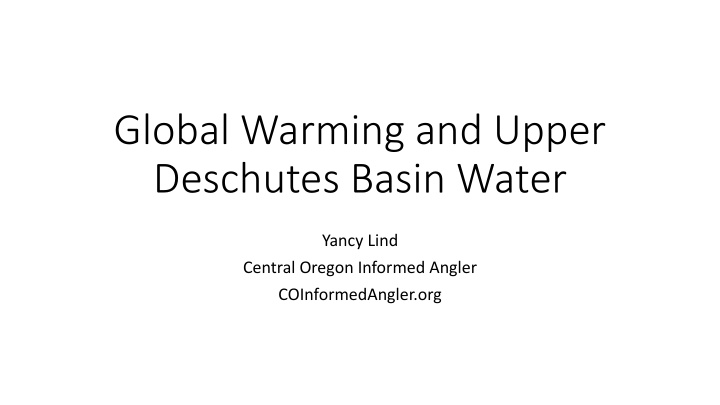



Global Warming and Upper Deschutes Basin Water Yancy Lind Central Oregon Informed Angler COInformedAngler.org
Fourth National Climate Assessment • Required by Congress to be updated every 4 years, most recently in November 2018 • Contains 12 summary findings including one on water: The quality and quantity of water available for use by people and ecosystems across the country are being affected by climate change, increasing risks and costs to agriculture, energy production, industry, recreation, and the environment. https://nca2018.globalchange.gov/ The actual image from the government report website home page!
“Understanding how climate change will affect water supply is one of the most pressing issues of our time. Substantial changes are projected in the types of precipitation (rain vs. snow) that will fall in the region, as are smaller, but potentially important, changes in the total annual precipitation. Combined with earlier snowmelt, these changes could cause decreased summer streamflows, and some high-elevation streams may dry up .” • Most of Bend’s drinking water comes from Metolius River Bridge Creek, a high elevation stream. USDA Forest Serivce , PNW Science Findings, “Flows of the Future— How Will Climate Change Affect Streamflows in the Pacific Northwest?”, July 2016 http://www.fs.fed.us/pnw/publications/scifi.shtml
Snow = Water = Life • Snowpack is an amazingly effective water storage and slow release mechanism • Snowpack melting through porous lava rock in the Cascades fills a huge aquifer along with our lakes and rivers • Whether global warming brings drought or more rain, the snowpack is shrinking
Diminishing Snowpack Will Push the Hydrograph to Earlier in the Year
Oregon is in a Multi- Year Drought
Current Snow Pack • Below average and unlikely to make up for past years • Forecast for the remainder of the year is for below average precipitation and higher than average temperatures • 6 of the past 10 years have had below average snowpack https://www.wcc.nrcs.usda.gov/ftpref/data/water/wcs/gis/maps/or_swepctnormal_update.pdf
Recent Reports • “OSU study finds Cascade snowpack likely to diminish significantly in coming decades” – The Oregonian, 1/15/19 • Source report: https://agupubs.onlinelibrary.wiley.com/doi/10.1029 /2018GL081080 • “Oregon’s snowpack is once again below normal. But how often do we reach 'normal' anymore?” – Statesman Journal 1/10/2019 • https://www.statesmanjournal.com/story/news/201 9/01/10/oregons-snowpack-below-normal-average- average-meaning/2537799002/
Global Warming is Happening Locally Now • For the first time ever, Wickiup Reservoir was completely drained this summer by NUID • 2 nd largest reservoir in Oregon • It started irrigation season full but with low snowpack • Historically, snow melt would replenish much of it
Current Impacts • Loss of wild, native fish due to warm water, lack of water • Trout, mountain whitefish, salmon, steelhead • Salmon & steelhead could soon be extinct in the Columbia Basin • Rivers have been closed to fishing due to damaging high temperatures • Rise of invasive warm water species • Reservoirs are being closed due to harmful algae blooms
Current Ocean Impacts • Rising temperatures are causing a collapse in the food web • Ocean temps have risen 40% more than predicted only 5 years ago; 2018 was the warmest on record • No plankton > forage fish > seabirds, salmon & steelhead > seals & orcas • Ocean acidification and hypoxia (oxygen deficiency) in Oregon • Impacting estuaries and near shore marine environments where clams, crabs, shrimp, and juvenile fish including salmon and rockfish reside • Oysters can no longer naturally reproduce in some areas • Other shellfish are plummeting on the coast
Locally, Water is Controlled by Irrigators • There is still a lot of water but it is controlled by irrigators • Water is over allocated and there are no new surface or groundwater supplies
Local Irrigation Districts http://dbbcirrigation.com/
Local Rivers are Irrigation Canals • With the exception of the Metolius, there is nothing natural about flows in major local rivers. • Flows in the Deschutes used to be amazingly constant year round • Now they alternate between unnatural highs and lows that are deadly to aquatic life https://www.usbr.gov/pn/hydromet/destea.html
This is NOT a Local Food Issue • There’s still plenty of water for real food production + people + wildlife if the water is properly managed • Water is delivered through leaky canals with about half lost in transit • Central Oregon Irrigation District is the largest with 3,700 “patrons” • Less than 4% of the water is used to grow what most would consider crops • Over 96% is pasture and hay or simply a big lawn and water feature • 27% of this land is still flood irrigated • A delivery system first used in Mesopotamia 5,000 years ago • In Deschutes County, most irrigators are not farmers • Jefferson and Crook Counties do have significant farming
There are Potential Solutions • Modernization of water rights & required More Local conservation by irrigators • Could solve looming water problems for people, agriculture, and fish & wildlife • Government regulation and enforcement • A smaller population • The human race has more than doubled in my lifetime • After a few years of decreases, in 2018 C02 Greatest Impact emissions in the US were the highest in 8 years
Recommend
More recommend